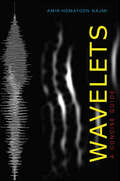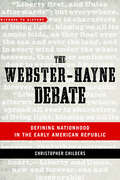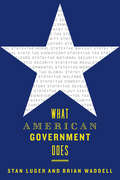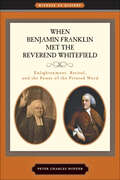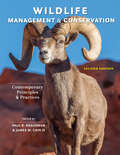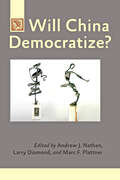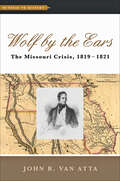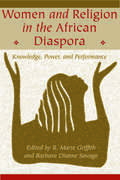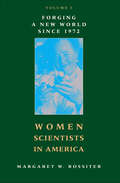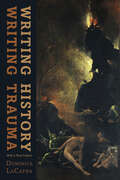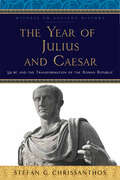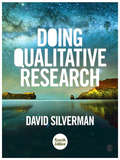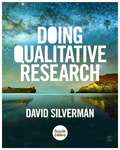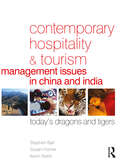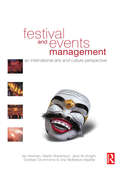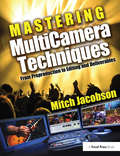- Table View
- List View
Wavelets: A Concise Guide
by Amir-Homayoon NajmiIntroduced nearly three decades ago as a variable resolution alternative to the Fourier transform, a wavelet is a short oscillatory waveform for analysis of transients. The discrete wavelet transform has remarkable multi-resolution and energy-compaction properties. Amir-Homayoon Najmi’s introduction to wavelet theory explains this mathematical concept clearly and succinctly. Wavelets are used in processing digital signals and imagery from myriad sources. They form the backbone of the JPEG2000 compression standard, and the Federal Bureau of Investigation uses biorthogonal wavelets to compress and store its vast database of fingerprints. Najmi provides the mathematics that demonstrate how wavelets work, describes how to construct them, and discusses their importance as a tool to investigate and process signals and imagery. He reviews key concepts such as frames, localizing transforms, orthogonal and biorthogonal bases, and multi-resolution. His examples include the Haar, the Shannon, and the Daubechies families of orthogonal and biorthogonal wavelets.Our capacity and need for collecting and transmitting digital data is increasing at an astonishing rate. So too is the importance of wavelets to anyone working with and analyzing digital data. Najmi’s primer will be an indispensable resource for those in computer science, the physical sciences, applied mathematics, and engineering who wish to obtain an in-depth understanding and working knowledge of this fascinating and evolving field.
Wavelets: A Concise Guide
by Amir-Homayoon NajmiIntroduced nearly three decades ago as a variable resolution alternative to the Fourier transform, a wavelet is a short oscillatory waveform for analysis of transients. The discrete wavelet transform has remarkable multi-resolution and energy-compaction properties. Amir-Homayoon Najmi’s introduction to wavelet theory explains this mathematical concept clearly and succinctly. Wavelets are used in processing digital signals and imagery from myriad sources. They form the backbone of the JPEG2000 compression standard, and the Federal Bureau of Investigation uses biorthogonal wavelets to compress and store its vast database of fingerprints. Najmi provides the mathematics that demonstrate how wavelets work, describes how to construct them, and discusses their importance as a tool to investigate and process signals and imagery. He reviews key concepts such as frames, localizing transforms, orthogonal and biorthogonal bases, and multi-resolution. His examples include the Haar, the Shannon, and the Daubechies families of orthogonal and biorthogonal wavelets.Our capacity and need for collecting and transmitting digital data is increasing at an astonishing rate. So too is the importance of wavelets to anyone working with and analyzing digital data. Najmi’s primer will be an indispensable resource for those in computer science, the physical sciences, applied mathematics, and engineering who wish to obtain an in-depth understanding and working knowledge of this fascinating and evolving field.
The Webster-Hayne Debate: Defining Nationhood in the Early American Republic (Witness to History)
by Christopher ChildersTwo generations after the founding, Americans still disagreed on the nature of the Union. Was it a confederation of sovereign states or a nation headed by a central government? To South Carolina Senator Robert Y. Hayne and others of his mindset, only the vigilant protection of states;€™ rights could hold off an attack on the southern way of life, which was undergirded by slavery. Massachusetts Senator Daniel Webster, on the other hand, believed that the political and economic ascendancy of New England;¢;‚¬;€?and the nation;¢;‚¬;€?required a strong, activist national government. In The Webster-Hayne Debate, Christopher Childers focuses on the sharp dispute that engaged Webster and Hayne in January 1830. During Senate discussion of western land policy, Childers explains, the senators;€™ exchanges grew first earnest and then heated, finally landing on the question of union;¢;‚¬;€?its nature and its value in a federal republic. Childers argues that both Webster and Hayne, and the factions they represented, saw the West as key to the success of their political plans and sought to cultivate western support for their ideas.A short, accessible account of the conflict and the related issues it addressed, The Webster-Hayne Debate captures an important moment in the early republic. Ideal for use in college classrooms or for readers interested in American history, this book examines a pivotal moment and a critical problem in the history of US politics. It also shows how Americans grappled with the issues of nationalism, sectionalism, and the meaning of union itself;¢;‚¬;€?issues that still resonate today.
The Webster-Hayne Debate: Defining Nationhood in the Early American Republic (Witness to History)
by Christopher ChildersTwo generations after the founding, Americans still disagreed on the nature of the Union. Was it a confederation of sovereign states or a nation headed by a central government? To South Carolina Senator Robert Y. Hayne and others of his mindset, only the vigilant protection of states;€™ rights could hold off an attack on the southern way of life, which was undergirded by slavery. Massachusetts Senator Daniel Webster, on the other hand, believed that the political and economic ascendancy of New England;¢;‚¬;€?and the nation;¢;‚¬;€?required a strong, activist national government. In The Webster-Hayne Debate, Christopher Childers focuses on the sharp dispute that engaged Webster and Hayne in January 1830. During Senate discussion of western land policy, Childers explains, the senators;€™ exchanges grew first earnest and then heated, finally landing on the question of union;¢;‚¬;€?its nature and its value in a federal republic. Childers argues that both Webster and Hayne, and the factions they represented, saw the West as key to the success of their political plans and sought to cultivate western support for their ideas.A short, accessible account of the conflict and the related issues it addressed, The Webster-Hayne Debate captures an important moment in the early republic. Ideal for use in college classrooms or for readers interested in American history, this book examines a pivotal moment and a critical problem in the history of US politics. It also shows how Americans grappled with the issues of nationalism, sectionalism, and the meaning of union itself;¢;‚¬;€?issues that still resonate today.
What American Government Does
by Stan Luger Brian WaddellIt has become all too easy to disparage the role of the US government today. Many Americans are influenced by a simplistic anti-government ideology that is itself driven by a desire to roll back the more democratically responsive aspects of public policy. But government has improved the lives of Americans in numerous ways, from providing income, food, education, housing, and healthcare support, to ensuring cleaner air, water, and food, to providing a vast infrastructure upon which economic growth depends. In What American Government Does, Stan Luger and Brian Waddell offer a practical understanding of the scope and function of American governance. They present a historical overview of the development of US governance that is rooted in the theoretical work of Charles Tilly, Karl Polanyi, and Michael Mann. Touching on everything from taxes, welfare, and national and domestic security to the government’s regulatory, developmental, and global responsibilities, each chapter covers a main function of American government and explains how it emerged and then evolved over time. Luger and Waddell are careful to both identify the controversies related to what government does and those areas of government that should elicit concern and vigilance. Analyzing the functions of the US government in terms of both a tug-of-war and a collaboration between state and societal forces, they provide a reading of American political development that dispels the myth of a weak, minimal, non-interventionist state.What American Government Does represents a major contribution to the scholarly debate on the nature of the American state and the exercise of power in America.
What American Government Does
by Stan Luger Brian WaddellIt has become all too easy to disparage the role of the US government today. Many Americans are influenced by a simplistic anti-government ideology that is itself driven by a desire to roll back the more democratically responsive aspects of public policy. But government has improved the lives of Americans in numerous ways, from providing income, food, education, housing, and healthcare support, to ensuring cleaner air, water, and food, to providing a vast infrastructure upon which economic growth depends. In What American Government Does, Stan Luger and Brian Waddell offer a practical understanding of the scope and function of American governance. They present a historical overview of the development of US governance that is rooted in the theoretical work of Charles Tilly, Karl Polanyi, and Michael Mann. Touching on everything from taxes, welfare, and national and domestic security to the government’s regulatory, developmental, and global responsibilities, each chapter covers a main function of American government and explains how it emerged and then evolved over time. Luger and Waddell are careful to both identify the controversies related to what government does and those areas of government that should elicit concern and vigilance. Analyzing the functions of the US government in terms of both a tug-of-war and a collaboration between state and societal forces, they provide a reading of American political development that dispels the myth of a weak, minimal, non-interventionist state.What American Government Does represents a major contribution to the scholarly debate on the nature of the American state and the exercise of power in America.
When Benjamin Franklin Met the Reverend Whitefield: Enlightenment, Revival, and the Power of the Printed Word (Witness to History)
by Peter Charles HofferIn the 1740s, two quite different developments revolutionized Anglo-American life and thought—the Enlightenment and the Great Awakening. This book takes an encounter between the paragons of each movement—the printer and entrepreneur Benjamin Franklin and the British-born revivalist George Whitefield—as an opportunity to explore the meaning of the beginnings of modern science and rationality on one hand and evangelical religious enthusiasm on the other.There are people who both represent the times in which they live and change them for the better. Franklin and Whitefield were two such men. The morning that they met, they formed a long and lucrative partnership: Whitefield provided copies of his journals and sermons, Franklin published them. So began one of the most unique, mutually profitable, and influential friendships in early American history. By focusing this study on Franklin and Whitefield, Peter Charles Hoffer defines with great precision the importance of the Anglo-American Atlantic World of the eighteenth century in American history. With a swift and persuasive narrative, Hoffer introduces readers to the respective life story of each man, examines in engaging detail the central themes of their early writings, and concludes with a description of the last years of their collaboration. Franklin’s and Whitefield’s intellectual contributions reach into our own time, making Hoffer's readable and enjoyable account of these extraordinary men and their extraordinary friendship relevant today.Also in the Witness to History seriesThe Huron-Wendat Feast of the Dead: Indian-European Encounters in Early North America by Erik R. SeemanKing Philip's War: Colonial Expansion, Native Resistance, and the End of Indian Sovereignty by Daniel R. MandellThe Caning of Charles Sumner: Honor, Idealism, and the Origins of the Civil War by Williamjames Hull HofferBloodshed at Little Bighorn: Sitting Bull, Custer, and the Destinies of Nations by Tim Lehman
Wildlife Management and Conservation: Contemporary Principles and Practices
by Paul R. Krausman James W. CainThe definitive textbook for students of wildlife management, now updated to cover the latest techniques, tools, and topics.Wildlife Management and Conservation presents a clear overview of the management and conservation of animals, their habitats, and how people influence both. The relationship among these three components of wildlife management is explained in chapters written by leading experts and is designed to prepare students for careers in which they will be charged with maintaining healthy animal populations. To be successful wildlife professionals, they will need to find ways to restore depleted populations, reduce overabundant, introduced, or pest species, and manage relationships among various human stakeholders. This book gives them the basic knowledge necessary to accomplish these goals.This second edition, which is updated throughout, features several new and expanded topics, including communication in the wildlife profession, fire science, Indigenous models of management and conservation, plant–animal interactions, quantitative analysis of wildlife populations, and a detailed glossary. The book also covers:• Human dimensions of wildlife management• Animal behavior• Predator–prey relationships• Structured decision making• Issues of scale in wildlife management• Wildlife health• Historical context of wildlife management and conservation• Hunting and trapping• Nongame species• Nutrition ecology• Water management• Climate change• Conservation planningThe most widely used foundational text in the field, this is the perfect resource not only for students but also for early career professionals and those in related fields who need to understand the core tenets and tools of wildlife conservation and management.Contributors: C. Jane Anderson, Bart M. Ballard, Warren B. Ballard, John A. Bissonette, Clint Boal, Scott B. Boyle, Leonard A. Brennan, Robert D. Brown, James W. Cain III, Tyler A. Campbell, Michael J. Cherry, Michael R. Conover, Daniel J. Decker, Randall W. DeYoung, Jonathan B. Dinkins, W. Sue Fairbanks, Selma N. Glasscock, James B. Grand, Michael J. Haney, James R. Heffelfinger, Scott E. Henke, Fidel Hernandez, Davie G. Hewitt, C. L. Hoving, David A. Jessup, Heather E. Johnson, Winifred B. Kessler, John L. Koprowski, Paul R. Krausman, William P. Kuvlesky, Jr., Roel R. Lopez, R. W. Mannan, Scott Mills, Michael S. Mitchell, Michael L. Morrison, Anna M. Muñoz, John F. Organ, Katherine L. Parker, William F. Porter, Shawn J. Riley, Steven S. Rosenstock, Michael C. Runge, Susan P. Rupp, William F. Siemer, Robert J. Steidl, Kelley M. Stewart
Wildlife Management and Conservation: Contemporary Principles and Practices
by Paul R. Krausman And James W. Cain IIIThe definitive textbook for students of wildlife management, now updated to cover the latest techniques, tools, and topics.Wildlife Management and Conservation presents a clear overview of the management and conservation of animals, their habitats, and how people influence both. The relationship among these three components of wildlife management is explained in chapters written by leading experts and is designed to prepare students for careers in which they will be charged with maintaining healthy animal populations. To be successful wildlife professionals, they will need to find ways to restore depleted populations, reduce overabundant, introduced, or pest species, and manage relationships among various human stakeholders. This book gives them the basic knowledge necessary to accomplish these goals.This second edition, which is updated throughout, features several new and expanded topics, including communication in the wildlife profession, fire science, Indigenous models of management and conservation, plant–animal interactions, quantitative analysis of wildlife populations, and a detailed glossary. The book also covers:• Human dimensions of wildlife management• Animal behavior• Predator–prey relationships• Structured decision making• Issues of scale in wildlife management• Wildlife health• Historical context of wildlife management and conservation• Hunting and trapping• Nongame species• Nutrition ecology• Water management• Climate change• Conservation planningThe most widely used foundational text in the field, this is the perfect resource not only for students but also for early career professionals and those in related fields who need to understand the core tenets and tools of wildlife conservation and management.Contributors: C. Jane Anderson, Bart M. Ballard, Warren B. Ballard, John A. Bissonette, Clint Boal, Scott B. Boyle, Leonard A. Brennan, Robert D. Brown, James W. Cain III, Tyler A. Campbell, Michael J. Cherry, Michael R. Conover, Daniel J. Decker, Randall W. DeYoung, Jonathan B. Dinkins, W. Sue Fairbanks, Selma N. Glasscock, James B. Grand, Michael J. Haney, James R. Heffelfinger, Scott E. Henke, Fidel Hernandez, Davie G. Hewitt, C. L. Hoving, David A. Jessup, Heather E. Johnson, Winifred B. Kessler, John L. Koprowski, Paul R. Krausman, William P. Kuvlesky, Jr., Roel R. Lopez, R. W. Mannan, Scott Mills, Michael S. Mitchell, Michael L. Morrison, Anna M. Muñoz, John F. Organ, Katherine L. Parker, William F. Porter, Shawn J. Riley, Steven S. Rosenstock, Michael C. Runge, Susan P. Rupp, William F. Siemer, Robert J. Steidl, Kelley M. Stewart
Will China Democratize? (A Journal of Democracy Book)
by Andrew J. Nathan Larry Diamond Marc F. PlattnerWhile China has achieved extraordinary economic success as it has moved toward open markets and international trade, its leadership maintains an authoritarian grip, repressing political movements, controlling all internet traffic, and opposing any democratic activity. Because of its huge population, more than half the people in the world who lack political freedom live in China. Its undemocratic example is attractive to other authoritarian regimes. But can China continue its growth without political reform? In Will China Democratize?, Andrew J. Nathan, Larry Diamond, and Marc F. Plattner present valuable analysis for anyone interested in this significant yet perplexing question.Since the Journal of Democracy’s very first issue in January 1990, which featured articles reflecting on the then-recent Tiananmen Square massacre, the Journal has regularly published articles about China and its politics. By bringing together the wide spectrum of views that have appeared in the Journal’s pages—from contributors including Fang Lizhi, Perry Link, Michel Oksenberg, Minxin Pei, Henry S. Rowen, and Nobel laureate Liu Xiaobo—Will China Democratize? provides a clear view of the complex forces driving change in China's regime and society.Whether China will democratize—and if so, when and how—has not become any easier to answer today, but it is more crucial for the future of international politics than ever before.
Will China Democratize? (A Journal of Democracy Book)
by Larry Diamond Andrew J. Nathan Marc F. PlattnerWhile China has achieved extraordinary economic success as it has moved toward open markets and international trade, its leadership maintains an authoritarian grip, repressing political movements, controlling all internet traffic, and opposing any democratic activity. Because of its huge population, more than half the people in the world who lack political freedom live in China. Its undemocratic example is attractive to other authoritarian regimes. But can China continue its growth without political reform? In Will China Democratize?, Andrew J. Nathan, Larry Diamond, and Marc F. Plattner present valuable analysis for anyone interested in this significant yet perplexing question.Since the Journal of Democracy’s very first issue in January 1990, which featured articles reflecting on the then-recent Tiananmen Square massacre, the Journal has regularly published articles about China and its politics. By bringing together the wide spectrum of views that have appeared in the Journal’s pages—from contributors including Fang Lizhi, Perry Link, Michel Oksenberg, Minxin Pei, Henry S. Rowen, and Nobel laureate Liu Xiaobo—Will China Democratize? provides a clear view of the complex forces driving change in China's regime and society.Whether China will democratize—and if so, when and how—has not become any easier to answer today, but it is more crucial for the future of international politics than ever before.
Wolf by the Ears: The Missouri Crisis, 1819–1821 (Witness to History)
by John R. Van AttaFrom the early days of the republic, American leaders knew that an unpredictable time bombâ€�the question of slaveryâ€�lay at the heart of national politics. An implicit understanding between North and South helped to keep the issue at bay: northern states, where slavery had been set on course for extinction via gradual emancipation, tacitly agreed to respect the property rights of southern slaveholders; in return, southerners essentially promised to view slaveholding as a practical evil and look for ways to get rid of it. By 1819–1820, however, westward expansion had brought the matter to a head. As Thomas Jefferson wrote at the time, a nation dealing with the politically implacable issue of slavery essentially held the "wolf" by the earsâ€�and could neither let go nor hang on forever.In Wolf by the Ears, John R. Van Atta discusses how the sectional conflict that led to the Civil War surfaced in the divisive fight over Missouri statehood. The first organized Louisiana Purchase territory to lie completely west of the Mississippi River and northwest of the Ohio, Missouri carried special significance for both pro- and anti-slavery advocates. Northern congressmen leaped out of their seats to object to the proposed expansion of the slave "empire," while slave-state politicians voiced outrage at the northerners’ blatant sectional attack. Although the Missouri confrontation ultimately appeared to end amicably with a famous compromise that the wily Kentuckian Henry Clay helped to cobble together, the passions it unleashed proved vicious, widespread, and long lasting.Van Atta deftly explains how the Missouri crisis revealed the power that slavery had already gained over American nation building. He explores the external social, cultural, and economic forces that gave the confrontation such urgency around the country, as well as the beliefs, assumptions, and fears that characterized both sides of the slavery argument. Wolf by the Ears provides students in American history with an ideal introduction to the Missouri crisis while at the same time offering fresh insights for scholars of the early republic.
Women and Religion in the African Diaspora: Knowledge, Power, and Performance (Lived Religions)
by R. Marie GriffithThis landmark collection of newly commissioned essays explores how diverse women of African descent have practiced religion as part of the work of their ordinary and sometimes extraordinary lives. By examining women from North America, the Caribbean, Brazil, and Africa, the contributors identify the patterns that emerge as women, religion, and diaspora intersect, mapping fresh approaches to this emergent field of inquiry.The volume focuses on issues of history, tradition, and the authenticity of African-derived spiritual practices in a variety of contexts, including those where memories of suffering remain fresh and powerful. The contributors discuss matters of power and leadership and of religious expressions outside of institutional settings. The essays study women of Christian denominations, African and Afro-Caribbean traditions, and Islam, addressing their roles as spiritual leaders, artists and musicians, preachers, and participants in bible-study groups. This volume's transnational mixture, along with its use of creative analytical approaches, challenges existing paradigms and summons new models for studying women, religions, and diasporic shiftings across time and space.
Women Scientists in America: Forging a New World since 1972 (Women Scientists In America Ser.)
by Margaret W. RossiterThe third volume of Margaret W. Rossiter’s landmark survey of the history of American women scientists focuses on their pioneering efforts and contributions from 1972 to the present. Central to this story are the struggles and successes of women scientists in the era of affirmative action. Scores of previously isolated women scientists were suddenly energized to do things they had rarely, if ever, done before—form organizations and recruit new members, start rosters and projects, put out newsletters, confront authorities, and even fight (and win) lawsuits. Rossiter follows the major activities of these groups in several fields—from engineering to the physical, biological, and social sciences—and their campaigns to raise consciousness, see legislation enforced, lobby for passage of the Equal Rights Amendment, and serve as watchdogs of the media. This comprehensive volume also covers the changing employment circumstances in the federal government, academia, industry, and the nonprofit sector and discusses contemporary battles to increase the number of women members of the National Academy of Science and women presidents of scientific societies. In writing this book, Rossiter mined nearly one hundred previously unexamined archival collections and more than fifty oral histories. With the thoroughness and resourcefulness that characterize the earlier volumes, she recounts the rich history of the courageous and resolute women determined to realize their scientific ambitions.
Writing History, Writing Trauma (Parallax: Re-visions of Culture and Society)
by Dominick LaCapraTrauma and its aftermath pose acute problems for historical representation and understanding. In Writing History, Writing Trauma, Dominick LaCapra critically analyzes attempts by theorists and literary critics to come to terms with trauma and with the crucial role post-traumatic testimonies—notably Holocaust testimonies—assume in thought and in writing. These attempts are addressed in a series of six interlocking essays that adapt psychoanalytic concepts to historical analysis, while employing sociocultural and political critique to elucidate trauma and its aftereffects in culture and in people. This updated edition includes a substantive new preface that reconsiders some of the issues raised in the book.
Writing History, Writing Trauma (Parallax: Re-visions of Culture and Society)
by Dominick LaCapraTrauma and its aftermath pose acute problems for historical representation and understanding. In Writing History, Writing Trauma, Dominick LaCapra critically analyzes attempts by theorists and literary critics to come to terms with trauma and with the crucial role post-traumatic testimonies�notably Holocaust testimonies�assume in thought and in writing. These attempts are addressed in a series of six interlocking essays that adapt psychoanalytic concepts to historical analysis, while employing sociocultural and political critique to elucidate trauma and its aftereffects in culture and in people. This updated edition includes a substantive new preface that reconsiders some of the issues raised in the book.
The Year of Julius and Caesar: 59 BC and the Transformation of the Roman Republic (Witness to Ancient History)
by Stefan G. ChrissanthosThe year 59 BC—when Gaius Julius Caesar and Marcus Calpurnius Bibulus served as joint consuls—marked a major turning point in the history of the Roman Republic. It was a dramatic and momentous time of political intrigue, bloodshed, and murder, one that boasted some of the most famous personalities ever to grace the Roman historical stage. Arguing that this pivotal year demands extended study, Stefan G. Chrissanthos's The Year of Julius and Caesar is the first focused investigation of the period.Chrissanthos uses a single event as his centerpiece: the violent attack orchestrated by Caesar and the "First Triumvirate" on Bibulus and his followers in the Forum on April 4. Before that day, he reveals, 59 had been a typical year, one that provides valuable insight into Roman government and political gamesmanship. But the assault on Bibulus changed everything: the consul retired to his house for the rest of the year, allowing Caesar and his allies to pass legislation that eventually enabled Caesar to take complete control of the Roman state. This detailed reconstruction draws on archeological and literary evidence to describe a watershed year in the history of the late Roman Republic, establish an accurate chronology, and answer many of the important historical questions surrounding the year 59. Written in an engaging and accessible style, The Year of Julius and Caesar will appeal to undergraduates and scholars alike and to anyone interested in contemporary politics, owing to the parallels between the Roman and American Republics.
The Year of Julius and Caesar: 59 BC and the Transformation of the Roman Republic (Witness to Ancient History)
by Stefan G. ChrissanthosThe year 59 BC—when Gaius Julius Caesar and Marcus Calpurnius Bibulus served as joint consuls—marked a major turning point in the history of the Roman Republic. It was a dramatic and momentous time of political intrigue, bloodshed, and murder, one that boasted some of the most famous personalities ever to grace the Roman historical stage. Arguing that this pivotal year demands extended study, Stefan G. Chrissanthos's The Year of Julius and Caesar is the first focused investigation of the period.Chrissanthos uses a single event as his centerpiece: the violent attack orchestrated by Caesar and the "First Triumvirate" on Bibulus and his followers in the Forum on April 4. Before that day, he reveals, 59 had been a typical year, one that provides valuable insight into Roman government and political gamesmanship. But the assault on Bibulus changed everything: the consul retired to his house for the rest of the year, allowing Caesar and his allies to pass legislation that eventually enabled Caesar to take complete control of the Roman state. This detailed reconstruction draws on archeological and literary evidence to describe a watershed year in the history of the late Roman Republic, establish an accurate chronology, and answer many of the important historical questions surrounding the year 59. Written in an engaging and accessible style, The Year of Julius and Caesar will appeal to undergraduates and scholars alike and to anyone interested in contemporary politics, owing to the parallels between the Roman and American Republics.
Doing Qualitative Research: A Practical Handbook (4th edition)
by Professor David SilvermanIn the fourth edition of his best-selling textbook, David Silverman provides a step-by-step guide to planning and conducting qualitative research. Using real examples from real postgraduate students, the book makes it easy to link theory to methods and shows how to move from understanding the principles of qualitative research to doing it yourself. The new edition has been fully updated and now includes: - a brand new chapter on formulating a research question appropriate for qualitative research - an expanded discussion of the role of theory in research - extended discussion of case study research and the number of cases needed for effective qualitative research - further coverage of focus groups and analysing internet data - new student examples from around the world - a new section on the common pitfalls encountered in qualitative research - an expanded companion website with more student examples and videos. Filled with exercises to test your understanding and develop your skills, as well as David's own tips for research success based on years of experience, this book is essential reading for anyone doing qualitative research. Available with Perusall--an eBook that makes it easier to prepare for class Perusall is an award-winning eBook platform featuring social annotation tools that allow students and instructors to collaboratively mark up and discuss their SAGE textbook. Backed by research and supported by technological innovations developed at Harvard University, this process of learning through collaborative annotation keeps your students engaged and makes teaching easier and more effective. Learn more.
Doing Qualitative Research: A Practical Handbook (4th ediction) (PDF)
by Professor David SilvermanIn the fourth edition of his best-selling textbook, David Silverman provides a step-by-step guide to planning and conducting qualitative research. Using real examples from real postgraduate students, the book makes it easy to link theory to methods and shows how to move from understanding the principles of qualitative research to doing it yourself. The new edition has been fully updated and now includes: - a brand new chapter on formulating a research question appropriate for qualitative research - an expanded discussion of the role of theory in research - extended discussion of case study research and the number of cases needed for effective qualitative research - further coverage of focus groups and analysing internet data - new student examples from around the world - a new section on the common pitfalls encountered in qualitative research - an expanded companion website with more student examples and videos. Filled with exercises to test your understanding and develop your skills, as well as David's own tips for research success based on years of experience, this book is essential reading for anyone doing qualitative research. Available with Perusall--an eBook that makes it easier to prepare for class Perusall is an award-winning eBook platform featuring social annotation tools that allow students and instructors to collaboratively mark up and discuss their SAGE textbook. Backed by research and supported by technological innovations developed at Harvard University, this process of learning through collaborative annotation keeps your students engaged and makes teaching easier and more effective. Learn more.
Lily's Just Fine (Galloway Girls #1)
by Gill StewartLily couldn’t have planned life better herself. She lives in the best house in town and she’s dating the most popular boy in school. Everything else she can fix. Mum’s apathy? On it! The stuffy gala committee? Watch this space! Tom has enough on his plate without trying to drag Newton St Cuthbert into the 21st Century. His sister is sick and there’s nothing anyone can do. Not doctors, not his parents, and certainly not Lily Hildebrand. About the Galloway Girls series:Set in the west coast of Scotland, Galloway Girls is a contemporary YA series with a touch of romance. Newfound friendships and unexpected summer romances arise as four teens plan their futures and face adulthood. Summery and light-hearted while dealing with relatable teen issues such as family relationships and mental wellbeing, Galloway Girls is perfect for girls 14+ and fans of Lucy Powrie, Stephanie Perkins and Jenny Han.
Contemporary Hospitality and Tourism Management Issues in China and India: Today's Dragons and Tigers (1st Edition)
by Stephen Ball Kevin Nield Susan HornerThis book represents a comprehensive, authoritative and up-to-date analysis of key sectors in the hospitality and tourism industries in China and India, and will address the market's growing need for information on Tourism in China and India. The text will be written in an accessible style drawing on the authors' wealth of theoretical, educational and industry experience. The text will contain inputs from academic colleagues and commercial contacts from the identified region. Case studies will give real life experiences of hospitality and tourism companies and organisations operating in this region and will include interactive exercises and discussion points.
Festival and Events Management: An International Arts and Culture Perspective (1st Edition) (PDF)
by Ian YeomanFestival and Events Management: an international perspective is a unique text looking at the central role of events management in the cultural, tourism and arts industries. With international contributions from industry and academia, the text looks at the following: * Events amp; cultural environments * Managing the arts amp; leisure experience * Marketing, policies and strategies of art and leisure management Chapters include exercises, and additional teaching materials and solutions to questions are provided as part of an accompanying online resource.
Festival and Events Management (1st Edition): An International Arts And Culture Perspective
by Ian YeomanFestival and Events Management: an international perspective is a unique text looking at the central role of events management in the cultural, tourism and arts industries. With international contributions from industry and academia, the text looks at the following: * Events amp; cultural environments * Managing the arts amp; leisure experience * Marketing, policies and strategies of art and leisure management Chapters include exercises, and additional teaching materials and solutions to questions are provided as part of an accompanying online resource.
Mastering MultiCamera Techniques: From Preproduction to Editing and Deliverables (1st Edition)
by Mitch JacobsonFrom a basic two-camera interview to an elaborate 26 camera HD concert film, this comprehensive guide presents a platform-agnostic approach to the essential techniques required to set up and edit a multi-camera project. Actual case studies are used to examine specific usages of multi-camera editing and include a variety of genres including concerts, talk shows, reality programming, sit-coms, documentaries for television, event videography and feature films. Other features include:* Advanced multi-camera techniques and specialty work-flows are examined for tapeless amp; large scale productions with examples from network TV shows, corporate media projects, event videography, and feature films. * New techniques for 3D projects, 2k/4k media management and color correction are revealed. * Technical breakdowns analyze system requirements for monitoring, hard drives amp; RAIDs, RAM, codecs and computer platforms. * Apple Final Cut Pro, Avid Media Composer, Adobe Premiere Pro and several other software programs are detailed.* Tables, charts, screen-grabs, photos, web-links, blogs, tech school lists and other resource tools for further study.* Unique interviews with the 'Masters of Multi-Cam' including EMMY and academy award-winning directors and editors who share their project notes and give insight to award-winning techniques. 9780240811772
